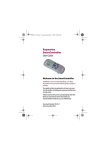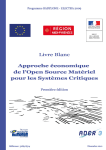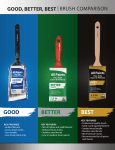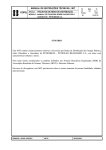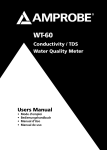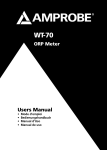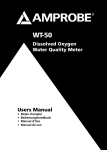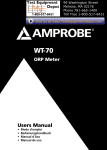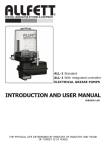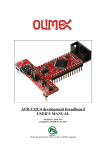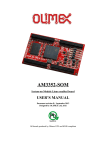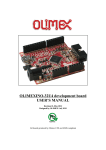Download 20110913Protei6
Transcript
Protei_006 - Qualification Basis Protei_006 Qualification Basis Table of contents Protei_006 Qualification Basis Table of contents Motivations DISCLAIMER 1. General System Description 2. Layout - list of components 3. Open-source requirements Accessible Modular Collaborative Licensed 4. Functionalities 5. Authority requirements Lighting 6. Operating principles 6.1 Storage 6.2 Transportation 6.3 Deployment 6.4 Oil Collection 6.4.1 Oil characterization 6.4.2 Oil spill characterization 6.4.3 Sorbent boom expected and tested performance. 6.5 Deployment of Protei for oil spill collection 6.5.1 Possible scenario : discharges from offshore oil installations Motivations Static recovery performance calculation 6.5.2 Compatibility with existing oil spill contingency plans 6.6 Safety requirements 6.6.1 Collection of oil-saturated boom 6.6.2 Cleaning Protei after oil exposure 6.7 Operating phases 6.8 Maintenance 7. Quality assurance and reliability 8. HSE requirements 9. List of abbreviations 10. References 11. Appendixes 11.1 Construction report: extract from the Protei Handbook 11.2 Testing protocol for sailing performance 11.3 Reports from testing on Aug. 13, 2011 11.4 Risk assessment 11.5 VanDoClean sorbent booms datasheets Protei_006 Qualification Basis | v.2011 09 XX | CC BY-SA-3.0 | [email protected] | p. X/X Protei_006 - Qualification Basis 11.6 Linear actuators technical drawings Protei_006 Qualification Basis | v.2011 09 XX | CC BY-SA-3.0 | [email protected] | p. X/X Protei_006 - Qualification Basis Motivations This document aims at describing the functionalities and global layout of the sixth prototype of Protei, in order to proceed to a standardized technology qualification process. It is not intended to be a manual nor a testing report. For detailed information about Protei_006 construction and design, you should refer to Protei Handbook. Protei is a sailing drone that can sail upwind and collect oil spills at sea. More info on the Protei website (http://protei.org) DISCLAIMER This document only describes the functionalities and global layout for the version 6 of Protei, referred to as Protei_006, which has been developed and tested trough the summer of 2011 in Rotterdam by the Protei_team. It is not suitable for qualifying another version of Protei. Also, please note that the disposal of the oil collection system is not treated in this document, and that specific laws apply in each country regarding the disposal of contaminated material such as oil. Protei designers should not be held responsible for any issue related to oil disposal. This work is licensed under a Creative Commons Attribution-ShareAlike 3.0 Unported License. Protei_006 Qualification Basis | v.2011 09 XX | CC BY-SA-3.0 | [email protected] | p. X/X Protei_006 - Qualification Basis 1. General System Description Protei is a sailing drone aiming at collecting oil spills at sea. It is using existing technologies in an innovative, low-cost and open-source design that semi-autonomously sails upwind, intercepting oil sheens going downwind. Protei is meant to be seaworthy, self-righting, inflatable, unbreakable, cheap and easy to manufacture for immediate response. Protei_006 Qualification Basis | v.2011 09 XX | CC BY-SA-3.0 | [email protected] | p. X/X Protei_006 - Qualification Basis Protei_006 is a 3m remote-controlled boat, controlled over radio by a user within 500m and line of sight. It has a segmented, shape-shifting hull, constructed of flexible spines that run lengthwise (through cross sectional bulkheads) and bend under stress. A flexible EPDM-Foam skin encases the skeleton. There is one 4m tall sail, and a large keel that extends downwards 1.2m from the hull. The majority of the boat’s ballast is housed at the lowest point of the keel, which provides most of the stability. This also enables Protei_006 to be self- righting. For steering and control, Protei_006 has three motors. The first one spins a winch to control the trim of the sail. The other two are attached to linear actuators that each control the articulation of the bow and the stern, which curve independently. The actuators pull and release cables that run throughout the longitudinal spines of the hull. Protei_006’s body is nearly cylindrical and very unstable. Most righting momentum comes from the ballast to right the vessel. The battery and linear actuators, which provide most of the weight of the boat, are at the bottom of the keel, along with a 25kg lead ballast. The main electronics, the winch, and the GPS are housed in the waterproof, shockproof pelican cases1 compartments of the hull (which make up the separate segments). Protei_006 stores GPS data from its trips. 2. Layout - list of components ○ Item Manufacturer Role Main constituent Mast Prolimit STX C60 RDM Holds the sail 60 %carbon fiber aluminum Sail Turns available wind into propulsive power 12V DC motors Bosch - 14.4V power drills move the linear actuators Protei_006 Qualification Basis | v.2011 09 XX | CC BY-SA-3.0 | [email protected] | p. X/X Protei_006 - Qualification Basis 12V geared DC motor windshield wiper rotate the winch Battery tube Contains the waterproof battery - PVC Linear actuators tubes Contain the linear actuators - waterproof PVC RC receiver tube Contains the receiver module Longitudinal Spines make the hull bendable PVC Section Ribs support the hull wood and foam Xbee PVC Sail Boom Neilpryde 230-275 X5 control of the angle and aluminum (hollow) shape of the sail Microcontroller Arduino Mega 2560 Computes the motor commands from RC input RC receiver Xbee Pro 900 Series 1 receive orders from the electronics remote control GPS module MediaTek MT3329 Arduino Mega + electronics stores the positions of Protei in a SD card electronics provides power supply for GPS module rechargeable NiMH *lead-free* IELK1-1-72-100.-01 controls general power supply — except GPS module Motor drivers Elechouse Freescale HBridge control the motor from microcontroller input electronics 12V Battery 12V, 10Ah provides power supply for motors and electronics. NiMH Skin PANA Foamtec GmbH smooth down the line and protect articulation system 9V battery (x2) General power switch Airpax Keel hull neoprene the generate lift and provide mainly wood. ballast reinforcement. Oil boom VanDoClean 6016-B absorbs the oil Steel polypropylene Central lifting hook point where Protei can be stainless steel lifted from Oil boom fixation point point where oil boom is attached at the stern of Protei stainless steel half ring Protei_006 Qualification Basis | v.2011 09 XX | CC BY-SA-3.0 | [email protected] | p. X/X Protei_006 - Qualification Basis Components of Protei_006 for remote control 3. Open-source requirements Protei is designed to be open-source, so that anyone can easily download the design and source code and contribute to its improvement. Here are some of the properties that Protei should meet : Accessible Protei should be as accessible and DIY as possible. Therefore, Protei should provide : ● availability of information (documentation, blueprints, manuals, etc.) ● ease of sourcing (use of traditional and/or simple components, public code repository, etc.) ● universal access (translation into languages other than English, user-friendly interface, ready-togo kits, etc.) In order to provide the potential actors of Protei with relevant information — regarding what they want to know and how much detail they want to go into — Protei should provide 3 levels of documentation : 1. Basic and simple explanations, main design principles with straightforward schematics. 2. User manual, extensive documentation on the product (design parameters, interface requirements, etc.) 3. Expert documents : source code (with comments), blueprints, CAD files, etc. Modular Protei should be as modular as possible to enable multiple, taylor made applications for Protei technology: oceanographic research, water quality monitoring, coastal radioactivity mapping, plastic waste collection, and more. Anyone should be able to adapt the design to fit its own purpose. Collaborative Protei end-usersshould be able to give feedback about their experience : failures, suggestions for improvements, feature requests, etc. on a public place (forum, bug and feature tracker, etc.) Public versioning system should also be provided to follow the different versions of Protei, and group the relevant documents in one place. Licensed ● Protei control programs should be under GNU GPL, meaning that people have ● Freedom to run the program ● Freedom to access the code ● Freedom to redistribute the program to anyone (under the same license) ● Documentation should be under Creative Commons BY-SA license (Attribution-ShareAlike), meaning that people are free to share and remix Protei work — as well as make commercial use of it — under the following conditions: ○ Attribution : people must clearly state that they use Protei work. ○ Share Alike : If people alter, transform, or build upon Protei work, they may distribute the resulting work only under the same or similar license to this one. Protei_006 Qualification Basis | v.2011 09 XX | CC BY-SA-3.0 | [email protected] | p. X/X ● Protei_006 - Qualification Basis Design should be under OSHW (Open Source Hardware) 1.0 license, which requires : ○ documentation, design files (in an open format) ○ necessary software to the use of Protei ○ free redistribution allowed ○ no discrimination or restriction in the re-use of Protei ○ technology neutrality 4. Functionalities This table shows the properties Protei_006 is meant to achieve.The criteria column is supposed to be a refinement of the global property, and can be associated with a validation protocol, in order to determine whether the technical solution is appropriate. These validation protocols are designed as “pass or fail” and intended to check if the solution is suitable for the intended property. These tests are opposed to the performance tests which aims at assessing the efficiency of Protei over the different properties that are meant to be achieved. For example : how long does the battery last ? how fast can we tack ? etc. [see Testing protocol for sailing performance in appendix 11.2] The tests that have been carried out so far by the Protei_team are mostly qualitative performance tests [see Testing Report from Aug. 13, 2011 in appendix] Property Criteria Solution Validation protocol Maneuverable Shape shifting Flexible hull Test #0 Steerable while towing Front rudder Test #0 sail Control of the sail Test #0 Optimised upwind Stable Self righting Unsinkable to Ballasted Keel Heel Protei manually to 90° and check if it comes back to its position on its own Light superstructure [Merge with cell above] Puncture proof Immerse Protei in the water (only the buoyancy material sail should be above waterline) and check if it comes back to floatation. Enough buoyancy Robust [Merge with cell above] Neoprene skin and use Reliability test needed of robust materials Protei_006 Qualification Basis | v.2011 09 XX | CC BY-SA-3.0 | [email protected] | p. X/X Protei_006 - Qualification Basis Collision safe Towing capable Can tow boom a COLREGS lights compliant Check if Protei light is visible from 1 mile sorbent Enough pulling force Boom hooking point Autonomous Attach boom and check speed > 1kn with normal wind (?). Conditions nominales. [Merge with cell above] Can be controlled by Xbee module radio up to 500 m Test #0 : check response when remote controlling from 500m Can navigate between GPS module predetermined way points Not implemented Protei_006 in 5. Authority requirements Protei_006 does not need an immatriculation number because it is part of the International Maritime Organization (IMO) exceptions list, as a Ship engaged on special service. Lighting Protei will be a sailing vessel and therefore should comply with the International Regulations for Preventing Collisions at Sea 1972 (COLREGS) published by IMO. Protei should therefore have a green light on the starboard side and a red light on the port side each showing from right ahead to 22.5 degrees abaft the beam on its respective side as well as a white light placed as nearly as practicable at the stern showing 67.5 degrees from right aft on each side of the vessel. These lights should be visible from 1 mile at least. 6. Operating principles 6.1 Storage Protei should be able to be stored for potentially long periods of time prior to deployment and should be able to be removed from storage and prepared for deployment within 2 hours of notification to do so. Protocols will be required for connecting electrical systems, charging batteries and otherwise priming the vehicle prior to deployment. 6.2 Transportation Protei should be able to be carried by three or four people when it is fully-assembled, but without its boom attached. On return to base with a fully oil-saturated boom, the boom will require a special handling device to remove it from the water since it is estimated it will weigh up to 300kg at this point. Personal protective equipment will also be required for personnel due to the toxic nature of the substances held within the boom. Procedures are required for cleaning the Protei Protei_006 Qualification Basis | v.2011 09 XX | CC BY-SA-3.0 | [email protected] | p. X/X Protei_006 - Qualification Basis following deployment and prior to returning it to storage. 6.3 Deployment Protei will weigh a considerable amount when fully assembled. She will require specialist equipment to lift it from the quay or from the deck of a ship in to the water coupled with its oil absorbing boom tail. If Protei is being launched from a ship a quick release hook should be attached to the lifting point and Protei lifted clear of the side of the ship and placed in the water. Once the weight of the boat is supported by the water the hook can be released. At this point the vessel can move away from the boat as the boom is fully payed out in to the water and stand off while the Protei orientates and gets underway. 6.4 Oil Collection 6.4.1 Oil characterization Oil is a complex product due to its wide variety of characteristics. Since Protei application concerns the collec- tion of oil spills at sea, we will focus on crude oils and petroleum products derived from crude oils only. The main properties of oil are viscosity, density, flash point and API gravity. • Viscosity is a measure of the resistance of oil to flow, expressed in mPa•s • Density is the mass of a given volume of oil, expressed in g•cm-3. It is the property used by the petroleum industry to define light or heavy crude oils. Density is also important because it indicates whether a par- ticular oil will float or sink in water. As the density of seawater is 1.03 g•cm-3, even heavy oils will usually float on it. • Flash Point is the temperature at which the liquid gives off sufficient vapors to ignite upon exposure to an open flame. A liquid is considered to be flammable if its flash point is less than 60°C. • API Gravity is based on the density of pure water, which has an arbitrarily assigned API gravity value of 10° (10 degrees). Oils with high densities have low API gravities and vice versa. Oil type Viscosity Density Flash Point API Gravity (mPa.s at 15°C) (g.cm-3 at 15°C) (°C) (dimensionless) Gasoline 0.5 0.72 -35 65 Diesel 2 0.84 >62 35 Light Crude [5—50] [0.78—0.88] [-30—30] [30—50] Heavy Crude [50—50,000] [0.88—1] [-30—60] [10—30] Intermediate Fuel Oil [1,000—15,000] [0.94—0.99] [80—100] [10—20] Bunker C [10,000—15,000] [0.96—1.04] >100 [5—15] [0.95—1] >80 [10—15] Marine fuel Heating fuel Crude Emulsion Oil [20,000—100,000] Protei_006 Qualification Basis | v.2011 09 XX | CC BY-SA-3.0 | [email protected] | p. X/X Protei_006 - Qualification Basis Characteristics of different types of oil [Fingas, 2001] and [Wikipedia,Flash Point,2011] 6.4.2 Oil spill characterization “After an oil spill on water, the oil tends to spread into a slick over the water surface. This is especially true of the lighter products such as gasoline, diesel fuel, and light crude oils, which form very thin slicks. Heavier crudes and Bunker C spread to slicks several millimetres thick. As a general rule, an oil slick on water spreads relatively quickly immediately after a spill. The outer edges of a typical slick are usually thinner than the inside of the slick at this stage so that the slick may resemble a “fried egg.” After a day or so of spreading, this effect diminishes. Winds and currents also spread the oil out and speed up the process. Oil slicks will elongate in the direction of the wind and currents, and as spreading progresses, take on many shapes depending on the driving forces. Oil sheens often precede heavier or thicker oil concentrations. If the winds are high (more than 20 km/h), the sheen may separate from thicker slicks and move downwind.” [Fingas, 2001] The BONN Agreement Oil Appearance Code [BAOAC, 2003] provides a general classification for the quantification of oil on the sea surface, based on its appearance. Layer Thickness Interval (µm) Litres per km2 Sheen (silvery/grey) 0.04 to 0.30 40 - 300 2 Rainbow 0.30 to 5.0 300 - 5000 3 Metallic 5.0 to 50 5000 - 50,000 4 Discontinuous true oil colour 50 to 200 50,000 - 200,000 5 Continuous true oil colour 200 to More than 200 200,000 - More than 200,000 Code Description Appearance 1 - BONN Agreement Oil Appearance Code [BAOAC, 2003] 6.4.3 Sorbent boom expected and tested performance. Protei_006 is equipped with standard VanDoClean 6016-B polypropylene booms that can absorb up to 150L of oil according to the manufacturer specifications (see Appendix). They can absorb any type of oil from light diesel to heavy crude, but experience has shown that they are more efficient on light oils, since heavy oils get stuck on the outer surface of the booms [Fingas, 2001] Protei_006 Qualification Basis | v.2011 09 XX | CC BY-SA-3.0 | [email protected] | p. X/X Protei_006 - Qualification Basis Charateristics of different types of sorbent booms (Data provided by manufacturers) We have also tested a new material from Aeroclay Inc., an American start-up company dedicated to commercializing an advanced material aerogel technology known as AeroClay®. The following results have been obtained by iterating a saturating-and-squeezing process [ASTM F716, 2009] on two samples : one of Aeroclay and one of standard polypropylene oil absorbent (VanDoClean 6016-B) The dry weight of the sample is referred as S0: S0 = 18g for the AeroClay® sample (16g of material + 2g for the surrounding pillow) S0 = 14g for the polypropylene sample Cycle # Total oil absorbed (OS) Net oil remaining (ON) Ratio OS/ S0 Cycle # Total oil absorbed (OS) Net oil remaining (ON) Ratio OS/ S0 1 168 g 82 g 9.33 1 102 g 62 g 7.29 2 164 g 86 g 9.11 2 94 g 58 g 6.71 3 162 g 90 g 9.00 3 88 g 52 g 6.29 4 142 g 80 g 7.89 5 148 g 80 g 8.22 6 148 g 82 g 8.22 AeroClay® saturation results -- TOO DAMAGED -- Polypropylene saturation results After 3 cycles, the polypropylene sample was so damaged by the squeezing process that it was considered to be unusable. On the other hand, the AeroClay® sample remained functional even after the sixth iteration. Our conclusion is that AeroClay® material seems very promising compared to existing industrial sorbent technology, because : 1. The global absorbency efficiency of AeroClay® (measured by the OS/S0 ratio) is superior to that of polypropylene. 2. It has been shown to be reusable even after a multiple squeezing cycles, unlike polypropylene. 3. From the preliminary results, it seems that the squeezed oil can be reused, whereas the current sorbent technologies usually end up burned or buried in landfills [Fingas, 2001] Protei_006 Qualification Basis | v.2011 09 XX | CC BY-SA-3.0 | [email protected] | p. X/X Protei_006 - Qualification Basis However, no large-scale test results are available yet, so we cannot guarantee the performance of AeroClay® over a full-scale recovery operation. Nevertheless, tests indicate that AeroClay® might represent a good solution for Protei’s oil absorbing system; an AeroClay® boom could last much longer than a traditional one. 6.5 Deployment of Protei for oil spill collection Protei_006 is designed to tow a sorbent boom that can collect light oils with the following typical characteristics : Density between 0.7 and 0.9 g.cm-3 (meaning API between 25 and 70) flash point above 60°C (Protei cannot handle flammable products) viscosity under 50 mPa.s Protei_006 is completely remote-controlled and cannot stay at sea for long, due to its battery limitations. Future versions of Protei should be able to sail autonomously for long periods of time — maybe weeks — and will therefore be able to collect oil on large areas. Furthermore, existing technologies such as skimmers are already very efficient on thick slicks (codes 4 and 5, see BAOAC table), and Protei is not intended to replace them. Instead, Protei is aimed at thin slicks (codes 1 to 3), on which existing technologies are not efficient currently. Protei_006 Qualification Basis | v.2011 09 XX | CC BY-SA-3.0 | [email protected] | p. X/X Protei_006 - Qualification Basis 6.5.1 Possible scenario : discharges from offshore oil installations Motivations One of the possible scenarios is the cleaning of water discharges released by offshore platforms. These still contain a fraction of oil and can cover very large surfaces areas in remote places. Although they meet the maximum oil content in water recommended by the Oslo-Paris convention (30g/mL)[OSPAR, 2001], these leaks still represent a sig- nificant amount of uncontrolled oil poured into the oceans. Protei could provide a cost-effective alternative to existing technologies on this particular scenario. Static recovery performance calculation Oil films from water produced by the offshore platforms are observed by SINTEF1 [SINTEF, 2011] : ● Up to 40 km from the platform ● Sheen / rainbow / metallic colors (corresponding to thicknesses up to 50 microns) ● Within the recommended limits regarding oil content ( < 30 ppm) [OSPAR, 2001] Aerial Estimates: ● Length : 1000m ● Width : 30 m ● Estimated area: 0.04 km2 ● 50 % Sheen ● 50 % Rainbow Total estimated volume: ● BAOAC: 7 L (low) - 106 L (high) Releases: ● 22.000 m3 / day ● 25 ppm oil ● 600 L oil / day ● 30 L oil / hour Upwind sailing path to comb the oil slick In a static calculation, the discharge is seen at a fixed instant: the oil slick has a constant volume. The objective is to clean this static oil slick in one go, with one boom. Is that possible? Assumptions: 1. discharge rate: 0 L oil / hour (fixed instant) 2. initial volume: 106 L (upper bound of the BAOAC estimated volume) 1SINTEF is the largest independent research organisation in Scandinavia. More information on www.sintef.no Protei_006 Qualification Basis | v.2011 09 XX | CC BY-SA-3.0 | [email protected] | p. X/X Protei_006 - Qualification Basis 3. wind coming from the North at a constant speed 4. Protei sailing at 1.5 knots upwind, constantly (even when tacking), for maximum sorbent efficiency 5. Sorbent boom: VanDoClean 6016-B with a 150 L capacity Calculation: 1. An upwind sailing path combing the whole static oil slick is instructed to Protei (see the yellow line on above picture) ● 82 points = 82 tacks ● 7920 m long path ● trip total duration at 1.5 knots : 2hrs 50min 2. This means that Protei needs to collect 106L of oil in 2hrs 50min. Since the absorption capacity of the boom is 150L, it is sufficient. The needed absorption rate is then 106L in 2hrs 50 min = 37.2L of oil/ hour to clean the whole oil slick in one go. This performance is considered optimal because of the static discharge assumption and the constant sailing speed assumption. When tacking, the aver- age sail boat slows down. With its articulated hull, Protei is meant to be able to tack without losing speed. The absorption rate of the sorbent boom needs to be measured to see how it compares to this optimal per- formance. If it compares favorably (higher than 37.2 L/hour), then it is theoretically possible to clean the whole oil slick in one go with one boom. However, the spill we are looking at is not a static one. It is a continuous leak from the platform discharge point, at a constant flow rate of 30L/hour, which represents 85L in 2hrs 50min. A dynamic calculation would be necessary. Here again, the absorption rate of the sorbent boom needs to be measured and compared to the figure of 30L of oil/hour. If it is more than 30L oil/hour, then it is possible. The challenge with measuring the absorption rate is that the value mostly depends on parameters such as the oil viscosity (it is harder to absorb a viscous product) and the thickness of the oil slick (if the slick is too thin, there is nothing to absorb). Therefore the measurement is very difficult to replicate and can only be obtained with a fixed set of parameters. In the real world the thickness of the oil slick changes from the border of the slick to its center, being usually thinner at the border [Fingas,2001]. 6.5.2 Compatibility with existing oil spill contingency plans Existing response plans for oil spills have been thoroughly tested and improved through the past decades in countries where major oil spills happened in the past, with specific procedures, proper equipment and trained personnel. For an example, see the American National Oil and Hazardous Substances Pollution Contingency Plan [US EPA 2011]. Protei is not intended to replace any of the technologies currently in use for such response plans. However, Protei might provide a good alternative if the conditions make it is too hazardous for human exposure, on which the existing contingency plans rely. These conditions might include extreme weather, hazardous chemicals, local terrorism or unstable political situation. 6.6 Safety requirements 6.6.1 Collection of oil-saturated boom How do we take a soaked boom at of the water for later waste treatment? ■ When transferring an amount Q_A of oil from an spilled area to an amount Q_B Protei_006 Qualification Basis | v.2011 09 XX | CC BY-SA-3.0 | [email protected] | p. X/X Protei_006 - Qualification Basis absorbed by the booms, how to make sure that Q_B is not released back to the water environment during the soaked booms collection phase? The risk here is to release large amounts of oil in a possibly more sensitive area (coast), in a more localized area (collection area). 6.6.2 Cleaning Protei after oil exposure Protei is still under development and does not provide yet the full procedure from building to end of life, including maintenance and instructions for deployment. In particular, Protei will need adapted cleaning of its hull before storage, maybe in a dedicated facility. Studies need to be carried out about the impact of oil on the materials that Protei uses currently and the related procedures to ensure that Protei will work reliably for every operation. 6.7 Operating phases ○ Standby ○ Transit : Protei is moving from one place to another, without any other action required (back to base for example) ○ In Operation : containment and/or recovery of the oil ○ Loss of transmission : if data transmission is lost with the base, Protei_006 will drift on the ocean without doing anything. Future versions of Protei will be able to sail autonomously even if transmission is lost. 6.8 Maintenance ○ A full “Owners” manual will be required to gather all procedures for maintenance and operation in the field with a sufficient amount of technical detail. ○ End of life: As explained earlier, Protei does not provide full life cycle procedures yet, and the Protei_team has no idea yet of how Protei vessels should be treated at the end of their lifes. Protei is trying to use environmental-friendly and recycled materials such as wood that do not require specific or costly procedures to dispose of. However, specific procedures need to be designed for the electronics and the materials that could harm the environment. 7. Quality assurance and reliability Some of the Protei components have been designed thinking of reliability. For instance : ● The limit switches that tell the microcontroller that the linear actuators have reached the end of the threaded rod are connected not only to the microcontroller but also to the main power directly. Therefore, if the software comes to fail, the power will still be switched off when hitting the limit switch, preventing the linear actuators or the motors to break down. ● The new version of the linear actuators [see technical drawings in appendix] has been designed in SolidWorks® and the main components were manufactured by a professional dutch machining company, Stork. ● Except from these parts for the linear actuators that are supposed to be very reliable, the rest of the parts are either standard DIY pieces (couplings, bolts, PVC pipes, etc.) or made out of recycled material such as plastic, wood, foam or metal with standard tools (power drills, grinders, etc.). The ease of sourcing for these parts make the maintenance and repair very easy even in remote places where Protei could operate. Future versions of Protei would need quality assurance protocols such as processes and tolerances for manufacturing as well as component test procedure. The first step towards this quality assurance protocol would be to set up a Quality Management System that would enable the Protei_team to give feedback on processes, manufacturing, choice of materials, Protei_006 Qualification Basis | v.2011 09 XX | CC BY-SA-3.0 | [email protected] | p. X/X Protei_006 - Qualification Basis etc. 8. HSE requirements Manipulating the boom should always be done with proper equipment (gloves, suit, etc.) Protei will be free of any sharp edge, so it can be manipulated by hand. The materials used should be recyclable and environmental-friendly, and prevent from any inner fluid leak. Protei will carry an external power switch, easily accessible. Protei_006 Qualification Basis | v.2011 09 XX | CC BY-SA-3.0 | [email protected] | p. X/X Protei_006 - Qualification Basis 9. List of abbreviations ● ● ● DIY CAD API : : : ● ● ● ● ● ● ● ● ● ● ● ● CC OSHW UNCLOS : HSE EEZ AIS : IMO COLREGS GNU GPL BAOAC : NiMH : : : : : : : : : Do-It Yourself Computer Aided Design Application Programming Interface (on Wikipedia) (or) American Petroleum Institute gravity Creative Commons (http://creativecommons.org/) Open Source Hardware (http://freedomdefined.org/OSHW) United Nations Convention on the Law of the Sea Health, Safety and Environment Exclusive Economic Zone Autonomous Identification System International Maritime Organization International Regulations for Preventing Collisions at sea GNU’s Not Unix — an open source operating system General Public License BONN Agreement Oil Appearance Code Nickel-metal hydride battery Protei_006 Qualification Basis | v.2011 09 XX | CC BY-SA-3.0 | [email protected] | p. X/X Protei_006 - Qualification Basis 10. References 1. Fingas, Mervin F. Oil Spill Science and Technology: Prevention, Response, and Cleanup. Burlington, MA: Elsevier/Gulf Professional Pub., 2011. Print. 2. Fingas, Mervin F., and Jennifer Charles. The Basics of Oil Spill Cleanup. Boca Raton: CRC, 2001. Print. 3. 4. 5. 6. 7. ASTM F716 — 09, Standard Test Methods for Sorbent Performance of Absorbents, 2009 ASTM F726 — 06, Standard Test Methods for Sorbent Performance of Adsorbents, 2006 SINTEF Oil Weathering and Appearance at Sea — May 2011 IMO Circular letter No.1886/Rev.3, IMO identification number scheme NOAA, A Guide for Spill Response Planning in Marine Environments, June 2010 (joint publication of U.S. DEPARTMENT OF COMMERCE, U.S. Coast Guard, U.S. Environmental Protection Agency, American Petroleum Institute) 8. OSPAR Recommendation 2001/1 for the Management of Produced Water from Offshore Installations, 2001 9. Aeroclay Inc. official website — http//aeroclayinc.com/ — Aug. 22nd 2011 10. US EPA — National Oil and Hazardous Substances Pollution Contingency Plan, 2011 11. Extended Guidelines for the Use of the Bonn Agreement Oil Appearance Code (BAOAC), Annex 4, 2003 Protei_006 Qualification Basis | v.2011 09 XX | CC BY-SA-3.0 | [email protected] | p. X/X Protei_006 - Qualification Basis 11. Appendixes 11.1 Construction report: extract from the Protei Handbook 11.2 Testing protocol for sailing performance Test name Protocol Output 0. Getting used to controlling Protei - Try to maintain a course that oscillates between close hauled and a beam reach (a close reach ideally) - Then try to sail at other points of sail - Keep a count of many times Protei accidentally tack, jibe or get stuck in irons - Try to do some tacking/jibing (jibing not too important) - Add oil boom and see how everything changes Entirely qualitative, pictures, videos, etc ● ● ● motor boat camera Walky Talkies A1. Global drag Pull rigid hull in straight line and measure the tension with the spring behind a motor boat. 1.set up a large transverse beam across the motor boat and attach Protei on it. Position it so that you have as little wave interference as possible. Observe how the hull naturally deforms without pulling any bending cable. Does the hull naturally bends when the motorboat turns? Is it possible to measure the natural bending by knowing the position of the cable / position of the cross section respective to each other ? indicative value in KG of tension at different speeds. Should increase with speed. Observe natural bending of hull Speeds: 1, 2 and 3 knots. ● ● spring scales motor boat, boat with a mast speedometer to measure boat speed large transverse beam camera set up fixation for transverse beam indicative value in KG of tension at 3 speeds (1, 2 and 3 knots) and 3 bendings ● ● ● A2. Bending Bend the hull to its maximum and define two intermediate drag bending positions that can be reached again easily - for example by counting the number of actuator rotations or length of cable pulled. Observe how Protei reacts to the bending: moving side ways? which side for which bending ? how much rudder angle do you need in the motorboat to Requirements ● ● ● ● spring scales motor boat boat speedometer Protei_006 Qualification Basis | v.2011 09 XX | CC BY-SA-3.0 | [email protected] | p. X/X Protei_006 - Qualification Basis align it to Protei again? increase in resistance? how much for how much bending (1-2-3 kn)? B1. VPP sailing speed B2. VPP heeling angle C1. Overall performance (Race Track) Measure the sailing speed at different wind speeds and course into the wind. Make sure that you measure the speed once the course is stable, not the transient speed when trimming the sail. Polar diagram: sailing speed at different wind speeds and courses ● Measure the heeling angle at different wind speeds and courses into the wind. Measure heeling angle from previously calibrated markings on the keel. Keep a list of which points of sailing are stable Polar diagram : heeling angle at differend wind speeds and courses ● Set up a race track with 3 buoys. Go upwind in a series of tacks and measure how much time is needed to complete a race track. Race track contains 3 legs: Cross Wind: can do several legs between #1 and #2 to get an average sailing speed in cross winds. Doing several legs also helps to correct any current effect. Upwind: define the breadth of the upwind zone based on the experience from test #0 : how long does it takes to tack? how much distance do you need to reach a good speed again? Measure at least 3 times this distance. Downwind: when going back from buoy 3 to 1-2. videos of track, time it takes to complete the track ● ● ● ● ● ● ● ● ● ● GPS logger (Protei speed/ course) anemometer GPS logger (Protei speed/ course) anemometer anemometer GPS logger (Protei speed and course) stopwatch 3 buoys motor boat camera with video or time laps tide currents prevision as a function of time detailed wind forecast, optimally with speed and direction Repeat the race track with only bow bending and only stern bending. Repeat with the boom and different ballasts: none, 5x weight, 10x weight For all tests, follow Protei on another sailing vessel to RC it. Wind measurement: measure as often as possible the wind speed and direction from the mother sailing vessel. Camera and GPS: make sure they are time synchronized. Protei_006 Qualification Basis | v.2011 09 XX | CC BY-SA-3.0 | [email protected] | p. X/X Protei_006 - Qualification Basis 11.3 Reports from testing on Aug. 13, 2011 Saturday 13 August the Protei team tested Protei_006 fully assembled in the water for the first time. The morning was spent preparing the boat for deployment (running dry tests, water-proofing and assembling). During one of the dry tests one of the linear actuators stopped responding and after some diagnosis it was decided that it was a problem with the motor and to fix it would make it impossible to test on time. Thus we decided to test with only the bow articulating. Transporting Protei was no joke but it was simpler than expected, we put her on the top of the van in one piece and had someone sit next to Protei and making sure we drove slowly. After some driving we were able to find a suitable spot for the test. We deployed Protei by lowering her into the water with lines. We also had one swimmer than helped deploy the boat correctly. in the future we hope to have access to a dock so that deployment becomes easier and we do not destroy the skin of the prototype by having it rub against the stone walls when lowering it down. Unloading Protei from the top of the van Remote controlling Protei under the rain Protei’s bow bending Protei and local authorities. A future collaboration ? The conditions for the test were actually relatively good. We had a steady state of 6-7 knots with gusts up to 10-11kts. Waves were not big (10cm absolute max). Once in the water we successfully established XBee communication and tested both the winch and bow Protei_006 Qualification Basis | v.2011 09 XX | CC BY-SA-3.0 | [email protected] | p. X/X Protei_006 - Qualification Basis actuation, and they seemed to work fine. After a minute of water time, the actuator stopped responding but the winch continued to respond throughout the whole test. Because of this failure we could not really observe if the steering by articulation worked. We had a line attached to Protei's stern in order to retrieve her. By holding this line we also had slight control of how she sailed. Because of the actuation problems most of the sailing that Protei did on the test was on a beam reach on a port tack (90 degrees from the wind with the wind on the port side). The boat was stable under these winds and did not heel over to capsize, (like when we tested the bare hull in 18-20 knots of wind). She made way surprisingly well without a rudder, the course was maintained passively and when we trimmed in the sheet, Protei would head up (turn towards the wind) as expected, not surprisingly the boat was not able to tack due to the low speeds she reached and the lack of steering. After seeing her sail the same path a couple of times, we had the visit of a police boat (the cops were very interested in Protei and talked to us for a couple of minutes about the project). Then we proceeded to make a self righting test by putting the masthead in the water. However as we lowered the mast, the mast snapped close to the base and that marked the end of the test. We retrieved Protei and fit her in the truck and headed back to the workspace for the diagnosis. We opened the battery tube and it was completely full of water! However the battery kept functioning even when it was completely submerged thus why Xbee communication was maintained all through the test. Then we opened the actuator tubes and saw that they were also completely full of water. Our first guess of how this happened was that the battery tube had leaked through a pvc patching we had done. However, the tube was tested again and it seemed water tight. Our next guess is that the water cooling caused the flooding in the actuator tubes and then spread to the battery tube via the Bowden cable openings. We will do some testing this coming week to find the exact cause of the problem and fix it. Post-Testing notes PARTS OF THE BOAT: XBee Box: DRY Kill Switch: DRY Winch: WET (1/2 cm water) Electronics box: WET (1/4 cm water) GPS: DRY Batteries, linear actuators, motors: Completely SOAKED, filled with water -Battery still works Water Cooling: WET (so water effectively flowed through) Mast: broken Skin: one hole from rubbing along the side of the rocks Next Steps: -Replace motor (find more powerful robust motors) -Redo water proofing (we should have ONE compartment / pelican case with a bilge pump rather than Protei_006 Qualification Basis | v.2011 09 XX | CC BY-SA-3.0 | [email protected] | p. X/X Protei_006 - Qualification Basis separate compartments for each item - but do we have enough time? 10 days...) -Replace the mast Linear Actuators: (unless we get new industrial ones) -replace the hall effect rotational sensor on the linear actuator (at least), but check what works -get better couplings for the motor shafts -Get New kill switch -patch the hole in the skin -re-wind the winch line -test the GPS 11.4 Risk assessment 11.5 VanDoClean sorbent booms datasheets 6016-B.pdf 6018-A.pdf 11.6 Linear actuators technical drawings AS_Protei_LA_nylondiscs_overview.PDF AS_Protei_LA_aluminumdiscs_overview.PDF Protei_006 Qualification Basis | v.2011 09 XX | CC BY-SA-3.0 | [email protected] | p. X/X

























